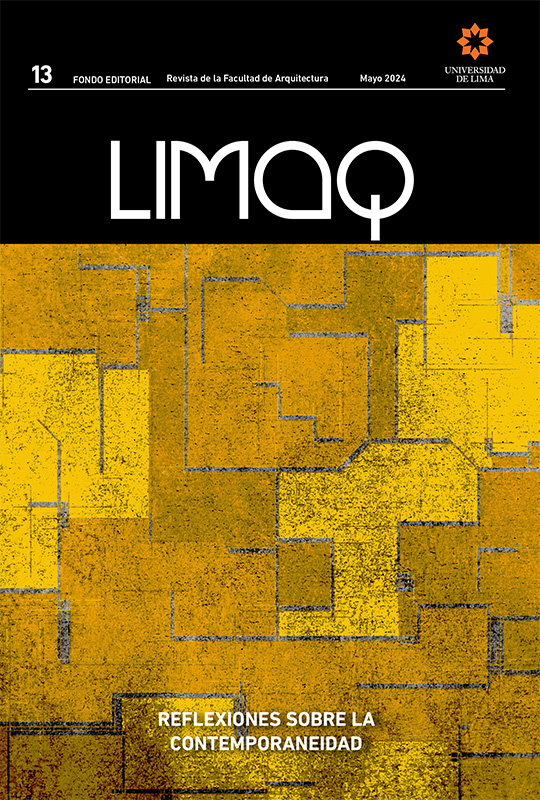The flux of ideas among underground projects: comparative study of Carré d’art’s Media center (1984), Beaux-Arts Palace of Lille (1992) and Gugg Río (2002)
DOI:
https://doi.org/10.26439/limaq2024.n013.6543Keywords:
underground, landscape, mediation, disappearance, horizontal-envelopeAbstract
The comparative study of unbuilt projects by Jean Nouvel —Media Library of Nîmes and Guggenheim Museum Rio— with the Palace of Fine Arts of Lille (Ibos and Vitart), exposes the similarities between underground buildings that explore disorientation and its dilution through use of glass/water as interface. Physical properties stress categories that we review - envelopes, facades and faces. The tendency to dematerialize makes them more involved with their places. We observe how the use of the basement alters the materialization of neoliberal discourse and we highlight projects that did not come out of paper, highlighting their contributions to the imagination of buildings integrated into cities. This blurs the limits of the visible in the realm of accelerated flows of late capitalism and globalized culture, discussed by Hays and Zaera-Polo. The relationship between the underground building and the city becomes inseparable, placed in a local perspective of deglobalization.
Downloads
References
Goulet, P. (Ed.). (1984). “Nîmes. Concours pour la Médiathèque et le Centre d’Art contemporain, oct 1984. Norman Foster, Frank Gehry, Jean Nouvel. L’Architecture d’Aujourd’hui, n. 236), diciembre 1984, p. 61-69.
Ibos, J. M., & Vitart, M. (s. f.). Jean Marc Ibos Myrto Vitart Arquitectes. Ibosvitart. Recuperado el 1 de marzo del 2022 de https://ibosvitart.com/
Ibos, J. M., & Vitart, M. (1992). Memorial Palácio de Belas Artes de Lille, 1992. Ibosvitart. Recuperado el 1 de marzo del 2022 de https://ibosvitart.com/works/museum-of-fi ne-arts/
Kamita, J. M. (2009). A catedral do século XXI: o caso do novo MIS. Arquitextos, (115.02).
Kamita, J. M. (2015). A nova Praça Mauá O Rio do espetáculo. Arquitextos, (187.02).
Moneo, R. (1999). Paradigmas Fin de Siglo. Arquitectura Viva. https://arquitecturaviva.com/articulos/paradigmas-fin-de-siglo
Moreira, C., & Rivera, P. (2002, noviembre). Quem tem medo de Jean Nouvel? O Guggenheim no Rio de Janeiro. Arquitextos, 3(028.02).
Morgan, C. L. (1999). Jean Nouvel: The Elements of Architecture. Thames & Hudson.
Nouvel, J. Presentación del Proyecto Museo Guggenheim Rio. Ateliers Jean Nouvel. Archivo M Rio de Janeiro, 2002.
Nouvel, J., & Baudrillard, J. (2000). Les Objets Singulièrs: Architecture et Philosophie. Calmann-Lévy.
Parent, C., & Virilio, P. (1996). Architecture Principe, 1966-1996. Les Éditions de l’Imprimeur.
Perrault, D. (2012). The Disappearance of Architecture: Between Presence and Absence [Video]. YouTube. https://www.youtube.com/watch?v=nTHH1XS4MrM
Rowe, C. et Slutzky, R. (1963). Transparency: Literal and Phenomenal (1955-1956) in Perspecta, 1963).
Scoffi er, R. (2009). Os quatro conceitos fundamentais da arquitetura contemporânea. En Santos de Oliveira, B., Lassance, G., Rocha-Peixoto, G. & Bronstein, L. (Coords.), Leituras em teoria da arquitectura 1. Conceitos (pp. 162-236). Viana & Mosley.
Segre, R. (20 04). Rio de Janeiro Metropolitano: Saudades da Cidade Maravilhosa. Arquitextos, 4(046.01).
Tschumi, B., & Cheng, I. (Eds.). (2004). The State of Architecture at the Beginning of the 21st Century. The Monacelli Press.
Virilio, P. (2015). Estética da Disparição. Contraponto.
Zaera-Polo, A. (2008). The politics of the envelope. Log, (13/14), 193-207. Recuperado el 1 de setiembre del 2021 de http://www.jstor.org/stable/41765249
Zaera-Polo, A. (2009). The politics of the envelope (Part II). Log, (16), 97-132. Recuperado el 1 de setiembre del 2021 de http://www.jstor.org/stable/41765281
Sección de la página de la Fundación Cartier dedicada al edificio. Recuperado el 1 de setiembre del 2021 de https://www.fondationcartier.com/batiment



